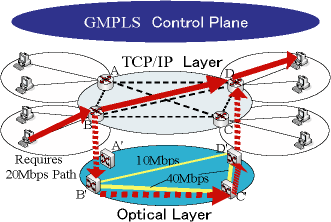The Rich Contents such as movie and music which are transmitted through network are increasing because of the explosive growth of Web services and of the Internet traffic. The opportunity of downloading Rich Contents increases especially music and movie due to Apple and Gyao. Also, more massive files are exchanged by the Internet with Peer to Peer application. Moreover, various providers began to delivery of many Rich Contents. Almost of all these contents delivery services deploy streaming technology. Heretofore, we need to wait until it receives all data to browse Rich Contents described above. Therefore, we can’t see Rich Contents by low-speed link such as telephone. For this reason, many providers deploy streaming which enables to real time reproduction of multimedia data with low speed link. But, streaming has three problems. First, we can’t see movie without network connection. Second, big load is given to a network. Third, the quality of movie being influenced by the power of the data transfer speed of a network circuit or a computer. So, it is hard to delivery HD contents by streaming because of the massive data. In this research, we aim to delivery Rich Contents such as HDTV contents.
Pre-dowonload by Prefetching Proxy Server
- A client accesses a Web server through a prefetching proxy server.
- In response to access of a client, a prefetching proxy server analyzes the HTML document of a Web server, and extracts the link to all mirror servers.
- Investigate the empty bandwidth and access speed of all mirror servers, select download link with shortest response time.
- A prefetching proxy server requests contents of the download link with shortest response time. A prefetching proxy server prefetches the contents and store into cache.
- If a client clicks a link, it will download from not a Web server but a prefetching proxy server.
Contents Delivery with Peer to Peer network
-
1.Web server through a prefetching proxy server.
2.A contents server searches the list of clients which are in agreement with the requested contents from a database. Measure Round Trip Time (RTT) of all mirrors by ping.
3.Dynamically write out XML, the client which has a shortest RTT as download link displays on a client. By writing a XML dynamically, the client which has a shortest RTT is displayed to a client as a download link.
4.A client requests the contents of the displayed download link.
5.Contents are downloaded in Peer to Peer network, and store into cache of a prefetching proxy server.
6.A client downloads contents from the cash of a prefetching proxy server.
Protocol Proxy
The request from a client to a server is performed by HTTP as usual. But, When the contents delivery from a server to a client, not using HTTP, FTP , but a P2P protocol, Optical Burst Switching (OBS). By this way, the download time of rich contents, such as a movie, can be shortened sharply.

Publication
- Tomohiro TSUJI, Junichiro HONMA, Sho SHIMIZU, Yutaka ARAKAWA, Naoaki YAMANAKA, “Prefetching Protocol Proxy with Optimal Mirror Selection and BurstTransmission,” Technical Report IEICE, PN2005-119, pp115-119, March 2006
Switching between Multicast and Unicast for load changing multicast
Surrogate Server is limited in the processing capacity. So Surrogate Server can not deal with a lot of user access.
In this research, we propose new content delivery method that three transmitting modes, which are unicast delivery, scheduled unicast and multicast, are adaptively changed with an increase in the number of simultaneous access at the contents server. In the scheduled unicast mode, timing of delivery contents is arranged when many users access the contents in short period. In the case that the number of access continues to increase and even the load in the server wouldn’t be mitigated by the setup of the holding time, the transmitting mode is switched from unicast to multicast. The number of the simultaneous connection is drastically reduced to assign multicast delivery interval.

Novel P2P network controled by GMPLS
As the fast spread of using P2P applications, P2P traffic largely effect on underlying physical networks. Some ISPs (Internet Service Provider) prohibit network customers from using P2P application because P2P traffic caused serious problem in their networks. We need to construct a novel P2P network architecture which is controllable and able to reduce burden for underlying networks.
We design and implement New Generation P2P Networks based on Dynamic Path Establishment with GMPLS. Using RSVP-TE for dynamic data path reservation, network users can obtain bandwidth guaranteed path. By this novel P2P network architecture, we can realize QoS guarantees for each users and appropriate bandwidth limitation of P2P application.



